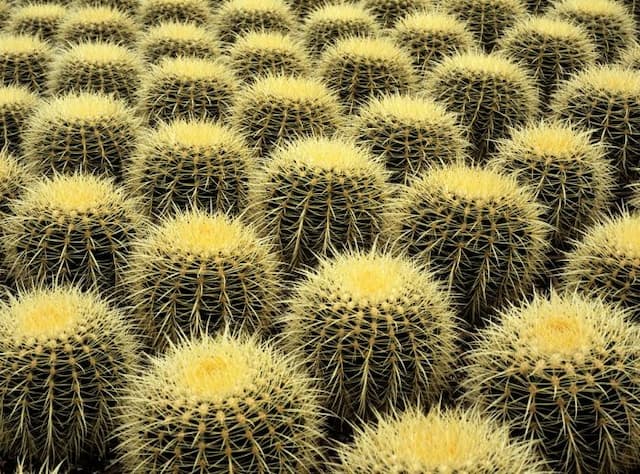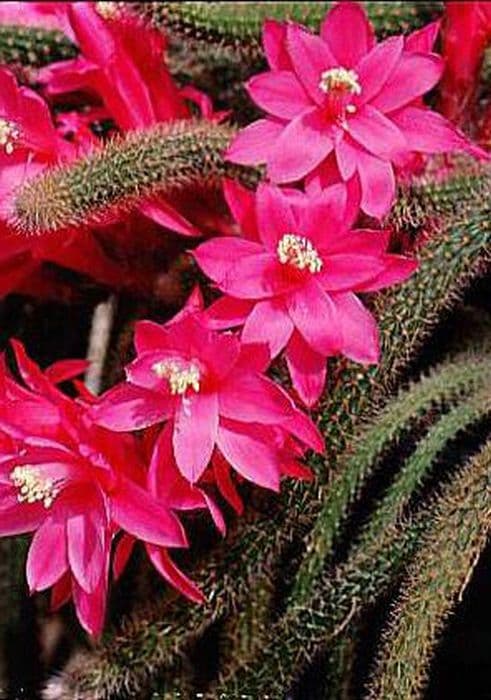Feather Cactus Parodia penicillata

ABOUT
Parodia penicillata, commonly known as the feather cactus, is an attractive and interesting plant notable for its bright green, globe-shaped body that often grows in clusters. The surface of the cactus is covered in pronounced, rib-like structures running vertically along the body. Punctuating these ribs are abundant white or yellowish spines, which, as its common name implies, are thin, flexible, and feather-like, providing the plant with a somewhat soft and fuzzy appearance despite its prickly nature. The feather cactus can produce vibrant yellow flowers that add a striking contrast to the green of the body. These flowers tend to emerge from the top or sides of the cactus, encircling it like a crown when in bloom. The blossoms generally have a funnel shape and are composed of numerous petals that can attract pollinators such as bees and birds to the plant. After flowering, the plant may develop small, spherical fruits that bear seeds for reproduction. The cactus also typically has woolly areoles, which are the spots from where the spines and flowers emerge. This white or yellow wool can be more dense at the top of the plant, especially around the growing point or crown, where the new spines and flowers will appear. The overall texture of the cactus, a mixture of its woolly areoles and feather-like spines, contributes significantly to its distinctive and appealing visual character.
About this plant
 Names
NamesFamily
Cactaceae
Synonyms
Feather Cactus, Comb Cactus
Common names
Notocactus penicillatus, Malacocarpus penicillatus.
 Toxicity
ToxicityTo humans
Parodia penicillata, commonly known as Feather Cactus, is not typically considered toxic to humans. There is no widely recognized evidence or reports of poisoning in humans following ingestion of parts of this plant. Hence, no specific symptoms of poisoning are associated with the Feather Cactus. However, as with any non-food plant, individual allergies or reactions may occur, and it is generally not advisable to eat ornamental plants.
To pets
Feather Cactus is also not known to be toxic to pets. There are no significant reports of toxicity in animals such as cats and dogs following ingestion of this plant. Thus, no specific symptoms of poisoning are tied to the Feather Cactus in pets. Still, it is advisable to prevent pets from ingesting plants as they could cause digestive upset or an individual allergic reaction.
 Characteristics
CharacteristicsLife cycle
Perennials
Foliage type
Evergreen
Color of leaves
Green
Flower color
Yellow
Height
0.98 feet (30 cm)
Spread
0.65 feet (20 cm)
Plant type
Cactus
Hardiness zones
9
Native area
South America
Benefits
 General Benefits
General Benefits- Aesthetic Appeal: Parodia penicillata, commonly known as Feather Cactus, sports vibrant yellow flowers that provide visual interest and enhance the beauty of any garden or indoor setting.
- Low Maintenance: As a cactus, it requires minimal water and care, making it suitable for those with busy lifestyles or for beginners in gardening.
- Drought Tolerance: The Feather Cactus is highly adaptable to dry conditions, requiring infrequent watering and thus conserving water resources.
- Suitable for Containers: It can be easily grown in pots, making it an excellent choice for those with limited space, such as apartment dwellers.
- Therapeutic Hobby: Tending to the Feather Cactus can offer a sense of tranquility and satisfaction, contributing to an individual’s overall well-being.
 Medical Properties
Medical PropertiesThis plant is not used for medical purposes.
 Air-purifying Qualities
Air-purifying QualitiesThis plant is not specifically known for air purifying qualities.
 Other Uses
Other Uses- Microhabitats for Insects: Parodia penicillata can serve as small ecological niches offering microhabitats for various insects, thus promoting biodiversity within gardens and greenhouses.
- Photo Subjects: Enthusiasts of macro photography often use plants like the Parodia penicillata as subjects for their photography due to their unique textures and forms.
- Therapeutic Horticulture: While not a medicinal use, the care of Parodia penicillata can be therapeutic, offering a sense of calm and accomplishment through gardening activities.
- Artistic Inspiration: The unique spherical shapes and patterns of the Parodia penicillata can inspire artists and designers in their work, leading to plant-themed artwork and patterns.
- Education: Parodia penicillata can be used in educational settings to teach students about plant biology, propagation, and the diversity of cacti species.
- Feng Shui: This plant is sometimes incorporated into Feng Shui practices where it is believed to add positivity and balance to a living space.
- Craft and Decoration: Dried flowers and spines can be used in crafting and as decorations in various DIY projects.
- Soundproofing Elements: The dense flesh and spines of cacti like Parodia penicillata may have sound-absorbing properties and can be a unique addition to soundproofing design elements in a room.
- Culinary Creativity: While not traditionally edible, creative chefs might use the unique form of the Parodia penicillata for plating and presentation of dishes in high-end cuisine.
- Modeling and Miniatures: Because of their small size, these cacti can be used in miniature landscapes or as part of model train sceneries.
Interesting Facts
 Feng Shui
Feng ShuiThe Feather Cactus is not used in Feng Shui practice.
 Zodiac Sign Compitability
Zodiac Sign CompitabilityThe Feather Cactus is not used in astrology practice.
 Plant Symbolism
Plant Symbolism- Resilience: Parodia penicillata, commonly known as the feather cactus, often symbolizes resilience because it thrives in harsh, arid environments, demonstrating an ability to withstand difficult conditions.
- Independence: The feather cactus is a symbol of independence, growing solitary in the wild, and managing its survival without the need for constant care.
- Beauty in Adversity: Despite growing in challenging circumstances, the feather cactus produces beautiful flowers, symbolizing that beauty can be found even in tough situations.
- Adaptability: This cactus has adapted to store water and survive with minimal resources, symbolizing adaptability and the ability to thrive in various conditions.
- Protection: With its spines, the feather cactus represents protection and defense, reminding us to guard our personal space and well-being.
- Persistence: The slow and steady growth of the feather cactus over many years stands for persistence and the idea that success comes to those who wait patiently.
 Water
WaterThe Lemon Ball Cactus (Parodia penicillata) should be watered moderately during the growing season, which runs from spring to fall. Water the plant thoroughly when the top inch of the soil feels dry to the touch, which is approximately once a week, but let the soil dry out completely between waterings to prevent root rot. During the dormant winter period, reduce watering to once every four to six weeks. Depending on the pot size and indoor conditions, you might need about 8 to 16 ounces of water every time you water the plant. Make sure the pot has good drainage to avoid excess water retention.
 Light
LightThe Lemon Ball Cactus thrives in bright, indirect sunlight. It is best to place it in a location where it can receive plenty of light without being exposed to the harsh midday sun, such as a south or west-facing window. If possible, provide a few hours of direct sunlight, especially in the morning, to encourage flowering and healthy growth.
 Temperature
TemperatureThe Lemon Ball Cactus prefers warm temperatures, ideally between 70°F and 90°F, but can tolerate temperatures as low as 40°F for short periods. It is not frost-tolerant, so it should be kept away from cold drafts and windows during the winter. The ideal temperature range encourages flowering and vibrant growth.
 Pruning
PruningPruning of the Lemon Ball Cactus is typically not required as it maintains a compact shape naturally. However, if you need to remove any dead or damaged spines, do so with care using tweezers or a soft brush. The best time for pruning, if necessary, is during the active growing season in the spring or summer.
 Cleaning
CleaningAs needed
 Soil
SoilThe Lemon Ball Cactus prefers a well-draining cactus mix with a slightly acidic to neutral pH, ranging from 6.0 to 7.5. A good soil recipe would be a blend of 50% potting soil, 25% pumice or perlite, and 25% coarse sand to ensure proper drainage and aeration.
 Repotting
RepottingLemon Ball Cacti should be repotted every two to three years or when they outgrow their pots. It's best to do this in the spring or early summer when the cactus is actively growing.
 Humidity & Misting
Humidity & MistingLemon Ball Cacti thrive in low humidity conditions typical of arid environments. They do well in indoor humidity levels, which generally range from 30% to 50%.
 Suitable locations
Suitable locationsIndoor
Place in bright, indirect light and avoid overwatering.
Outdoor
Needs full sun, well-draining soil, and shelter from heavy rain.
Hardiness zone
9-11 USDA
 Life cycle
Life cycleParodia penicillata, commonly known as the feather cactus, begins its life cycle as a seed, which requires well-drained soil and warm temperatures to germinate. After germination, the seedling slowly develops into a juvenile plant, exhibiting its characteristic globular shape with dense coverings of white spines. As the plant matures, it increases in size and may produce offsets or "pups" around its base, allowing asexual propagation. The feather cactus reaches maturity in several years and begins to bloom in the spring or summer, bearing yellow flowers at the crown of the cactus. Once pollinated, either by insects or manually by a grower, the flowers will develop into fruits containing seeds, thus completing the reproductive cycle and potentially beginning a new generation if the seeds are dispersed and find suitable conditions for growth. The feather cactus can live for many years, repeating the flowering and seeding cycle annually.
 Propogation
PropogationPropogation time
Spring-Early Summer
Propogation: The most popular method for propagating the Parodia penicillata, commonly known as the feather cactus, is by seeds. Propagation by seeds typically occurs in the spring or summer when temperatures are warmer, which is conducive to germination. To propagate, the seeds should be sown in a well-draining cactus mix and lightly covered with a layer of sand or fine grit. The soil must be kept moist but not waterlogged. It's important to provide adequate warmth, ideally around 70°F (21°C), and sunlight for germination to occur effectively. Seedlings usually appear within a few weeks and should be watered sparingly until they are well-established and can be transplanted into individual pots.








